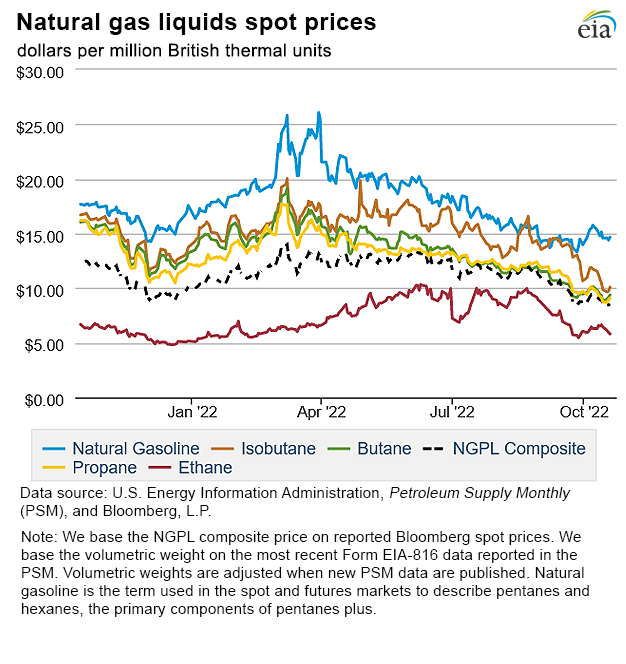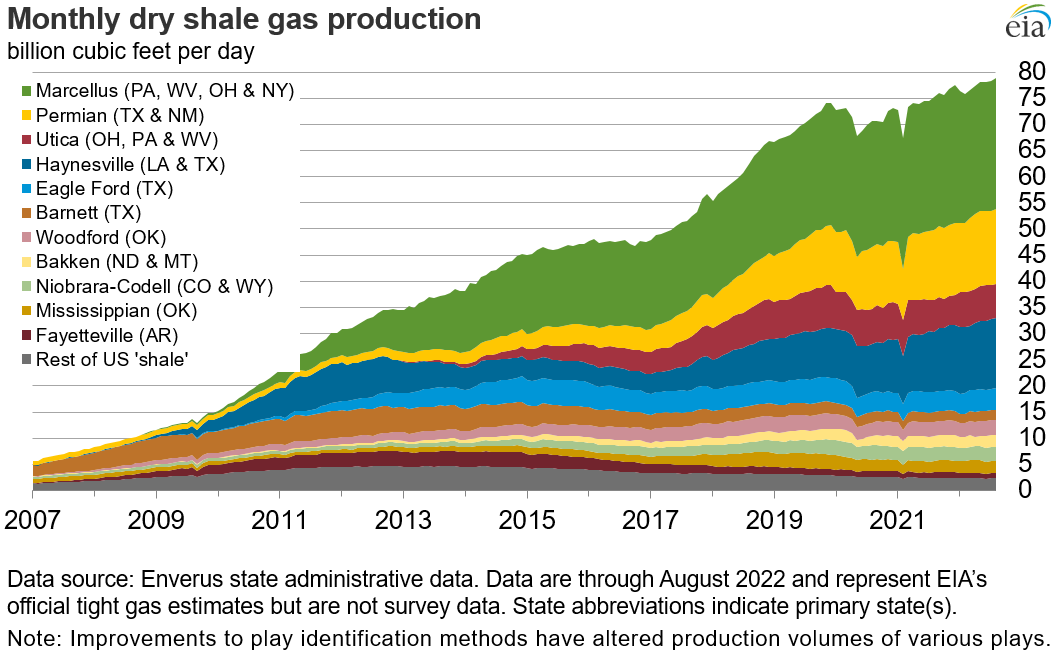In the News:
East region working natural gas in storage is the lowest in five years ahead of the 2022–2023 winter heating season
At the start of the 2022–2023 winter heating season (October–March), working natural gas inventories in underground storage facilities in the East region ended September 9% below the five-year (2017–2021) average and 6% below year-ago levels, according to data from our Natural Gas Storage Dashboard. In comparison, at the end of September 2021, working natural gas inventories were about 3% below the five-year average.
EIA defines five natural gas storage regions in the Lower 48 states, and the East region consists of 18 states, stretching from Florida to Maine. All of the East region’s natural gas storage facilities are located in the Northeast, and more than 85% of that storage is in three states—Pennsylvania (39%), Ohio (24%), and West Virginia (23%)—right in the middle of Appalachian Basin production activities.
The amount of natural gas in storage in the East region has been below its previous five-year average and close to or below the five-year range since the end of January. At the end of September, natural gas storage in the East region was 77% full, similar to levels on a percentage basis in the South Central and Midwest regions, and total storage in the Lower 48 states was 73% full.
This past summer (June 1–August 31) was the third hottest on record in the United States, which contributed to record consumption of natural gas in the electric power sector to meet air-conditioning demand in July. High natural gas consumption contributed to lower-than-average net injections into U.S. working natural gas storage during the summer months, and storage inventories remained below the five-year average all season.
Net injections into natural gas storage in the East region to build natural gas inventories will help supply the region with natural gas in the winter when demand exceeds supply. In addition, liquefied natural gas (LNG) imports, which can account for up to a third of New England’s natural gas supply on peak demand days, continue to account for a portion of the supply in the Northeast.
Despite a substantial increase in dry natural gas production in the winter in the Northeast region over the last 10 years—a result of significant growth in natural gas production from shale in the Appalachian Basin—the Northeast region continues to supplement pipeline natural gas with stored natural gas in the winter.
Last winter, natural gas demand (total consumption plus net exports out of the region) exceeded natural gas production and LNG imports in the Northeast region by 4.2 Bcf/d, according to data from PointLogic. This gap has narrowed since the winter of 2012–2013, when demand exceeded production and LNG imports by 6.3 Bcf/d. Over the last 10 years, natural gas production in the winter months has grown by almost 245% (24.6 Bcf/d) while demand grew by 135% (22.4 Bcf/d). Natural gas withdrawals from storage remain a critical component of supply in meeting winter demand.
Market Highlights:
(For the week ending Wednesday, October 19, 2022)Prices
- Henry Hub spot price: The Henry Hub spot price fell 97 cents from $6.47 per million British thermal units (MMBtu) last Wednesday to $5.50/MMBtu yesterday.
- Henry Hub futures prices: The price of the November 2022 NYMEX contract decreased 97.3 cents, from $6.435/MMBtu last Wednesday to $5.462/MMBtu yesterday. The price of the 12-month strip averaging November 2022 through October 2023 futures contracts declined 55.3 cents to $5.180/MMBtu.
- Select regional spot prices: Natural gas spot prices fell at most locations this report week (Wednesday, October 12 to Wednesday, October 19). Week-over-week price declines at major pricing hubs ranged from 97 cents/MMBtu at the Henry Hub to 29 cents/MMBtu at Transco Zone 6 New York.
- The price at the Henry Hub fell 97 cents from $6.47/MMBtu last Wednesday to $5.50/MMBtu yesterday. During the past five weeks, net injections of natural gas into underground storage have been above the five-year (2017–2021) average and have topped 100 billion cubic feet (Bcf). These large storage builds have helped inventory levels get closer to their five-year average ahead of the winter withdrawal season (November 1–March 31). In April, at the beginning of the natural gas refill season (April 1–October 31), U.S. working natural gas stocks were 17% below the five-year average. As of October 14, stocks were 5% below the five-year average.
- The price at the Chicago Citygate fell 57 cents this week from $5.84/MMBtu last Wednesday to $5.27/MMBtu yesterday, after increasing to a weekly high of $5.88/MMBtu on Tuesday as an early season winter storm brought snow and freezing temperatures to the region. Consumption of natural gas in the residential and commercial sectors in the Midwest increased 85%, or 3.1 billion cubic feet per day (Bcf/d), week over week, according to data from PointLogic. Temperatures in the Chicago Area averaged 44°F this week resulting in 145 heating degree days (HDD), 66 HDDs more than normal.
- Though most prices decreased this week, the price at the Waha Hub in West Texas, which is located near Permian Basin production activities, rose 57 cents, from $4.30/MMBtu last Wednesday to $4.87/MMBtu yesterday. Average weekly natural gas production in the Permian Basin fell by 0.5 Bcf/d week over week. Temperatures in the Midland-Odessa area averaged more than 4°F below normal this report week, resulting in 30 HDDs. The price increase at the Waha Hub and the price decrease at the Henry Hub narrowed the differential between the two hubs. The Waha Hub traded 63 cents below the Henry Hub price yesterday, compared with last Wednesday when it traded $2.17 below the Henry Hub price.
- International futures prices: International natural gas futures prices declined this report week. According to Bloomberg Finance, L.P., weekly average futures prices for liquefied natural gas (LNG) cargoes in East Asia decreased $2.71 to a weekly average of $32.11/MMBtu, and natural gas futures for delivery at the Title Transfer Facility (TTF) in the Netherlands, the most liquid natural gas market in Europe, decreased $8.53 to a weekly average of $37.30/MMBtu.
- Natural gas plant liquids prices: The natural gas plant liquids composite price at Mont Belvieu, Texas, fell by 58 cents/MMBtu, averaging $8.60/MMBtu for the week ending October 19. The price of ethane fell 4%, while the natural gas price at the Houston Ship Channel fell 8%. The ethane premium to natural gas widened by 30%. The price of ethylene rose 2%, widening the ethylene to ethane premium by 16%. The natural gasoline price fell 4%, following the price of Brent crude oil, which also fell 4%. The propane price fell 8%, widening the propane discount to crude oil by 2%. The normal butane price and isobutane price fell 7% and 13%, respectively.
Daily spot prices by region are available on the EIA website.
Supply and Demand
- Supply: According to data from PointLogic, the average total supply of natural gas fell by 0.8% (0.9 Bcf/d) compared with the previous report week. Dry natural gas production decreased by 1.3% (1.3 Bcf/d) from last week, and average net imports from Canada increased by 3.6% (0.2 Bcf/d) over the same period.
- Demand: Total U.S. consumption of natural gas rose by 9.2% (6.2 Bcf/d) compared with the previous report week, according to data from PointLogic. Natural gas consumed for power generation declined by 0.4% (0.1 Bcf/d) week over week. Industrial sector consumption increased by 2.8% (0.6 Bcf/d), while consumption in the residential and commercial sectors increased by 39.9% (5.7 Bcf/d). Natural gas exports to Mexico increased 5.9% (0.3 Bcf/d). Natural gas deliveries to U.S. LNG export facilities (LNG pipeline receipts) averaged 11.4 Bcf/d, or 0.6 Bcf/d higher than last week.
Liquefied Natural Gas (LNG)
- Pipeline receipts: Overall natural gas deliveries to U.S. LNG export terminals increased by 0.6 Bcf/d week over week to average 11.4 Bcf/d this report week. Natural gas deliveries to LNG export terminals in South Louisiana drove this increase, rising by 0.6 Bcf/d to 8.7 Bcf/d, while deliveries to South Texas were relatively flat at 2.3 Bcf/d, according to data from PointLogic. At the Cove Point terminal in Maryland, natural gas deliveries remained at 0 Bcf/d this week, as the terminal continues three weeks of annual planned maintenance that began on October 1.
- Vessels departing U.S. ports: Eighteen LNG vessels (eight from Sabine Pass, four from Cameron, and three each from Calcasieu Pass and Corpus Christi) with a combined LNG-carrying capacity of 67 Bcf departed the United States between October 13 and October 19, according to shipping data provided by Bloomberg Finance, L.P.
- LNG terminals: The LNG tanker Prism Brilliance arrived outside the Freeport LNG export terminal on Tuesday but remains anchored offshore. Boardwalk Pipelines, operator of the Gulf South Pipeline system, continues to report no flows to the Freeport LNG terminal. Before the terminal outage the pipeline regularly reported close to 1.8 Bcf/d of flows to the terminal.
Rig Count
- According to Baker Hughes, for the week ending Tuesday, October 11, the natural gas rig count decreased by 1 rig from a week ago to 157 rigs. The Marcellus added one rig, the Utica added two rigs, the Eagle Ford dropped two rigs, and the Arkoma Woodford and an unidentified producing region each dropped one rig. The number of oil-directed rigs increased by 8 rigs from a week ago to 610 rigs. The Ardmore Woodford, the Eagle Ford, the Permian, and the Williston each added one rig, and five rigs were added in unidentified producing regions. The Arkoma Woodford dropped one rig. The total rig count, which includes 2 miscellaneous rigs, now stands at 769 rigs, the highest level since March 20, 2020, and 226 more than the same week last year.
Storage
- The net injections into storage totaled 111 Bcf for the week ending October 14, compared with the five-year (2017–2021) average net injections of 73 Bcf and last year's net injections of 91 Bcf during the same week. Working natural gas stocks totaled 3,342 Bcf, which is 183 Bcf (5%) lower than the five-year average and 106 Bcf (3%) lower than last year at this time.
- According to The Desk survey of natural gas analysts, estimates of the weekly net change to working natural gas stocks ranged from net injections of 96 Bcf to 115 Bcf, with a median estimate of 105 Bcf.
- The average rate of injections into storage is 5% higher than the five-year average so far in the refill season (April through October). If the rate of injections into storage matched the five-year average of 7 Bcf/d for the remainder of the refill season, the total inventory would be 3,462 Bcf on October 31, which is 183 Bcf lower than the five-year average of 3,645 Bcf for that time of year.
See also:
Top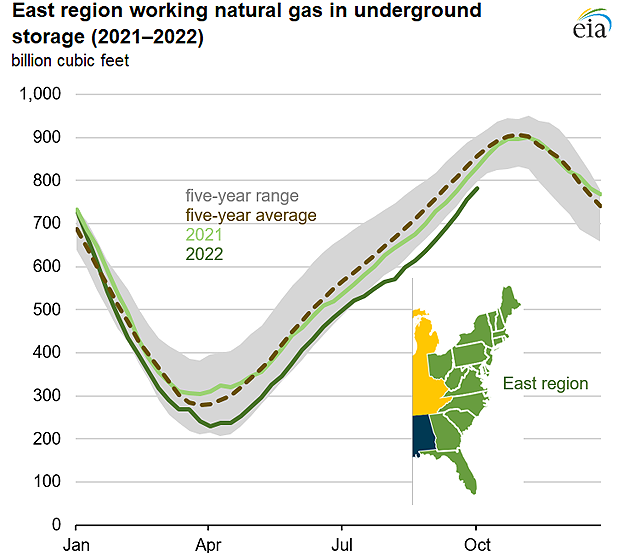
Data source: U.S. Energy Information Administration, Natural Gas Storage Dashboard
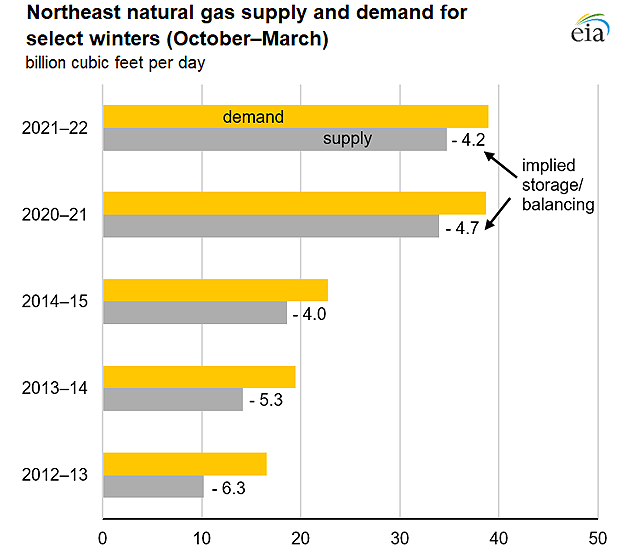
Data source: PointLogic
Note: Demand=total consumption (power, industrial, residential/commercial)+net (natural gas) flows+LNG natural gas deliveries (LNG exports)+fuel and pipe loss
Supply=dry natural gas production+LNG sendout (LNG imports)
LNG=liquefied natural gas
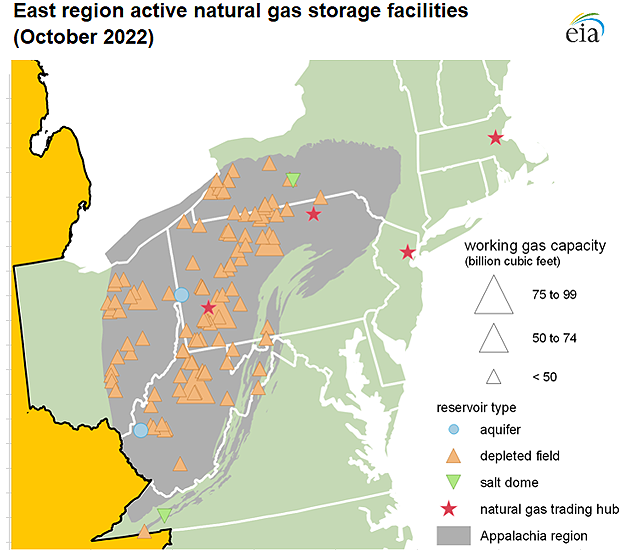
Data source: U.S. Energy Information Administration, EIA-191 Field Level Storage data
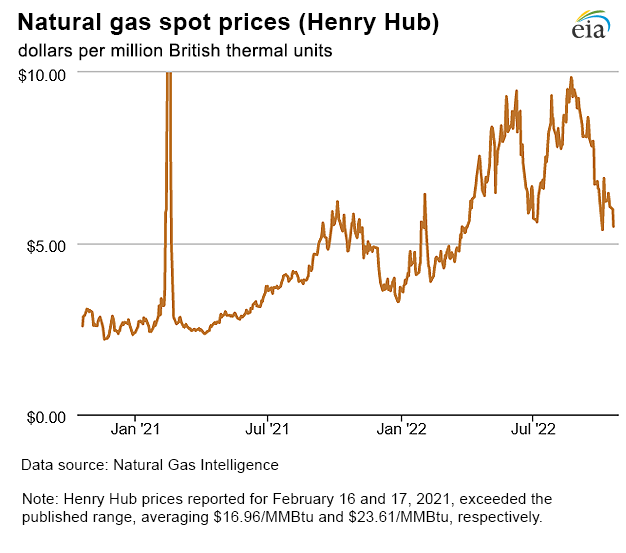
| Spot Prices ($/MMBtu) | Thu, 13-Oct |
Fri, 14-Oct |
Mon, 17-Oct |
Tue, 18-Oct |
Wed, 19-Oct |
|---|---|---|---|---|---|
| Henry Hub |
6.28 |
6.08 |
6.02 |
6.00 |
5.50 |
| New York |
5.40 |
5.14 |
5.71 |
5.78 |
5.13 |
| Chicago |
5.59 |
5.49 |
5.80 |
5.88 |
5.27 |
| Cal. Comp. Avg.* |
6.53 |
5.98 |
6.40 |
6.53 |
6.15 |
| Futures ($/MMBtu) | |||||
| November contract | 6.741 |
6.453 |
5.999 |
5.745 |
5.462 |
| December contract |
7.053 |
6.827 |
6.479 |
6.237 |
5.928 |
| Data source: Natural Gas Intelligence and CME Group as compiled by Bloomberg, L.P. *Avg. of NGI's reported prices for: Malin, PG&E Citygate, and Southern California Border Avg. |
|||||
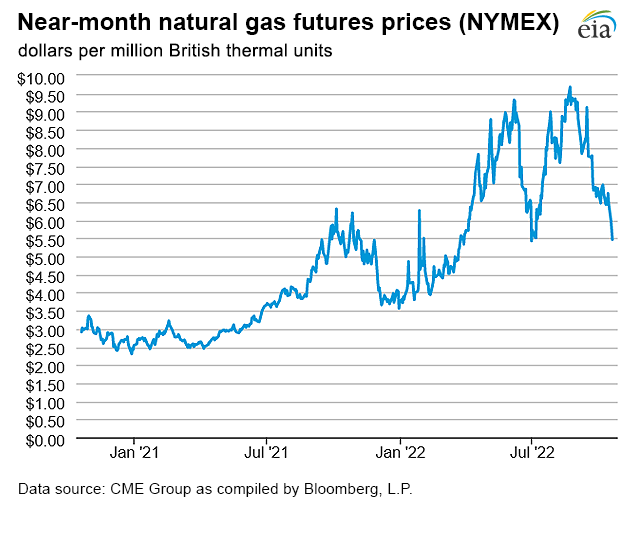
| U.S. natural gas supply - Gas Week: (10/13/22 - 10/19/22) | |||
|---|---|---|---|
Average daily values (billion cubic feet) |
|||
this week |
last week |
last year |
|
| Marketed production | 110.6 |
112.1 |
104.2 |
| Dry production | 98.6 |
99.9 |
94.4 |
| Net Canada imports | 5.6 |
5.4 |
5.4 |
| LNG pipeline deliveries | 0.3 |
0.1 |
0.1 |
| Total supply | 104.5 |
105.4 |
99.9 |
|
Data source: PointLogic | |||
| U.S. natural gas consumption - Gas Week: (10/13/22 - 10/19/22) | |||
|---|---|---|---|
Average daily values (billion cubic feet) |
|||
this week |
last week |
last year |
|
| U.S. consumption | 74.3 |
68.1 |
64.2 |
| Power | 31.0 |
31.1 |
30.0 |
| Industrial | 23.3 |
22.6 |
21.9 |
| Residential/commercial | 20.1 |
14.4 |
12.4 |
| Mexico exports | 6.1 |
5.8 |
6.2 |
| Pipeline fuel use/losses | 6.8 |
6.7 |
6.2 |
| LNG pipeline receipts | 11.4 |
10.8 |
10.9 |
| Total demand | 98.7 |
91.4 |
87.5 |
|
Data source: PointLogic | |||
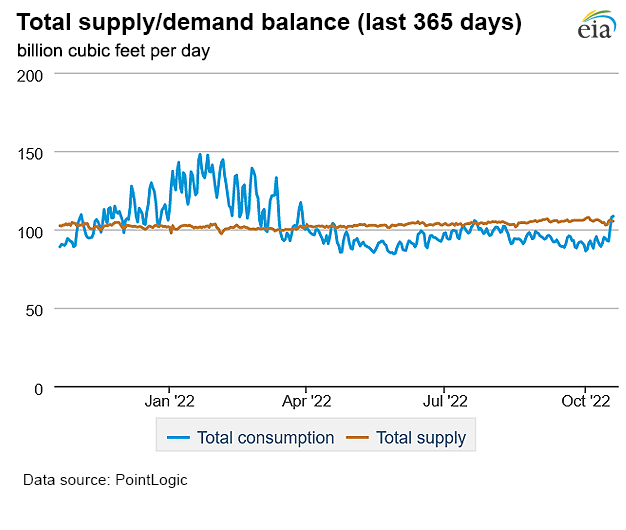
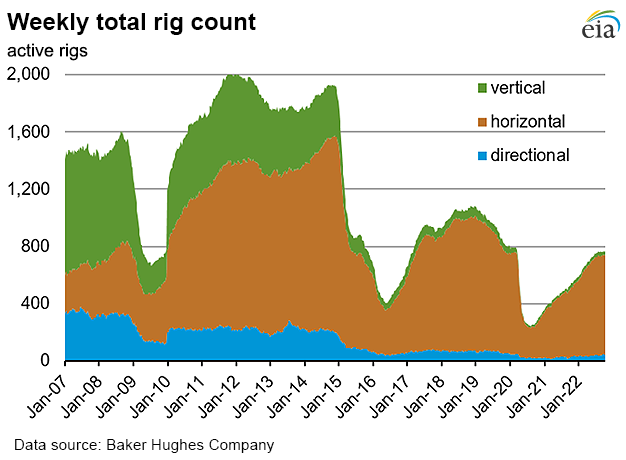
| Rigs | |||
|---|---|---|---|
Tue, October 11, 2022 |
Change from |
||
last week |
last year |
||
| Oil rigs | 610 |
1.3% |
37.1% |
| Natural gas rigs | 157 |
-0.6% |
60.2% |
| Note: Excludes any miscellaneous rigs | |||
| Rig numbers by type | |||
|---|---|---|---|
Tue, October 11, 2022 |
Change from |
||
last week |
last year |
||
| Vertical | 23 |
0.0% |
-23.3% |
| Horizontal | 705 |
1.0% |
46.6% |
| Directional | 41 |
0.0% |
28.1% |
| Data source: Baker Hughes Company | |||
| Working gas in underground storage | ||||
|---|---|---|---|---|
Stocks billion cubic feet (Bcf) |
||||
| Region | 2022-10-14 |
2022-10-07 |
change |
|
| East | 812 |
782 |
30 |
|
| Midwest | 987 |
952 |
35 |
|
| Mountain | 195 |
190 |
5 |
|
| Pacific | 249 |
249 |
0 |
|
| South Central | 1,099 |
1,058 |
41 |
|
| Total | 3,342 |
3,231 |
111 |
|
| Data source: U.S. Energy Information Administration Form EIA-912, Weekly Underground Natural Gas Storage Report | ||||
| Working gas in underground storage | |||||
|---|---|---|---|---|---|
Historical comparisons |
|||||
Year ago (10/14/21) |
5-year average (2017-2021) |
||||
| Region | Stocks (Bcf) |
% change |
Stocks (Bcf) |
% change |
|
| East | 858 |
-5.4 |
877 |
-7.4 |
|
| Midwest | 1,023 |
-3.5 |
1,030 |
-4.2 |
|
| Mountain | 211 |
-7.6 |
212 |
-8.0 |
|
| Pacific | 253 |
-1.6 |
290 |
-14.1 |
|
| South Central | 1,104 |
-0.5 |
1,116 |
-1.5 |
|
| Total | 3,448 |
-3.1 |
3,525 |
-5.2 |
|
| Data source: U.S. Energy Information Administration Form EIA-912, Weekly Underground Natural Gas Storage Report | |||||
| Temperature – heating & cooling degree days (week ending Oct 13) | ||||||||
|---|---|---|---|---|---|---|---|---|
HDDs |
CDDs |
|||||||
| Region | Current total |
Deviation from normal |
Deviation from last year |
Current total |
Deviation from normal |
Deviation from last year |
||
| New England | 78 |
-10 |
47 |
0 |
0 |
0 |
||
| Middle Atlantic | 73 |
-3 |
62 |
0 |
-2 |
-3 |
||
| E N Central | 92 |
12 |
83 |
0 |
-2 |
-23 |
||
| W N Central | 89 |
12 |
62 |
0 |
-4 |
-13 |
||
| South Atlantic | 44 |
5 |
42 |
25 |
-7 |
-24 |
||
| E S Central | 46 |
8 |
44 |
4 |
-12 |
-43 |
||
| W S Central | 7 |
-4 |
6 |
43 |
6 |
-28 |
||
| Mountain | 60 |
-16 |
-29 |
17 |
1 |
10 |
||
| Pacific | 4 |
-23 |
-57 |
23 |
12 |
23 |
||
| United States | 55 |
-2 |
31 |
14 |
-1 |
-11 |
||
|
Data source: National Oceanic and Atmospheric Administration Note: HDDs=heating degree days; CDDs=cooling degree days | ||||||||
Average temperature (°F)
7-day mean ending Oct 13, 2022
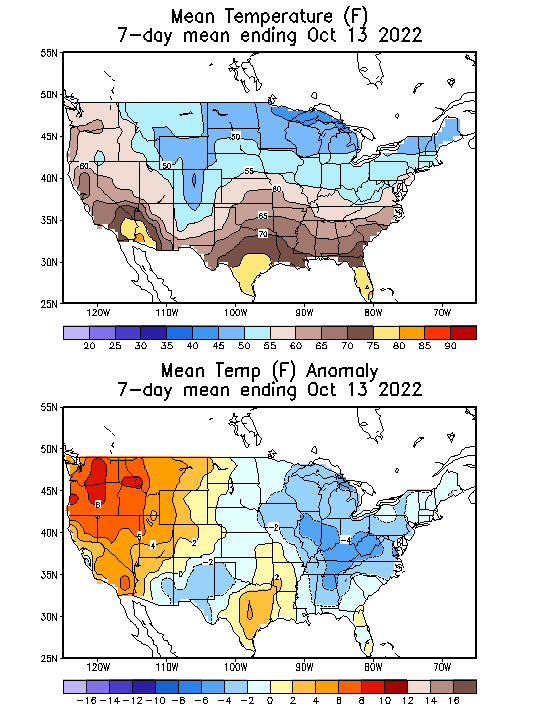
Data source: National Oceanic and Atmospheric Administration
Deviation between average and normal temperature (°F)
7-day mean ending Oct 13, 2022

Data source: National Oceanic and Atmospheric Administration

